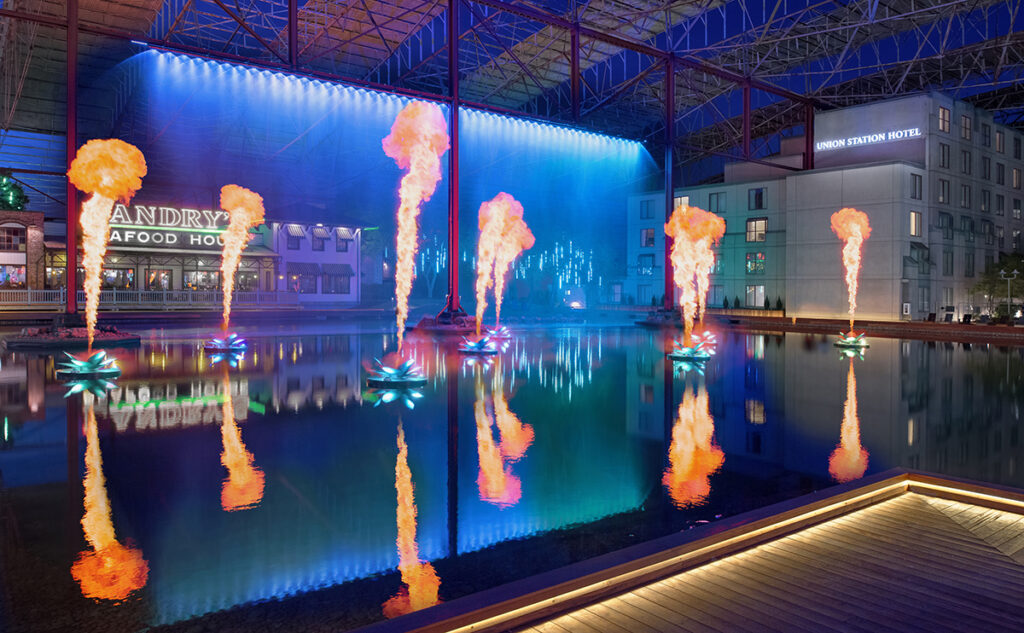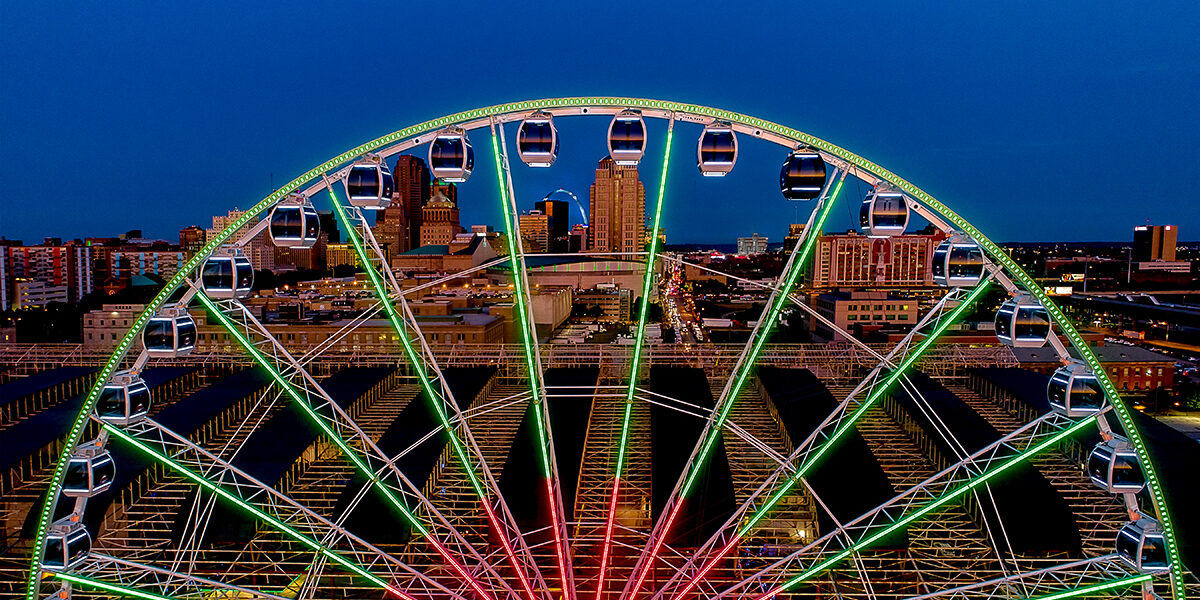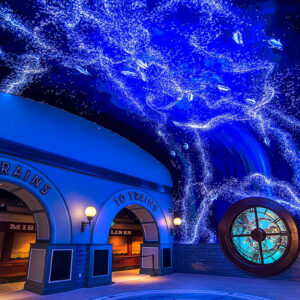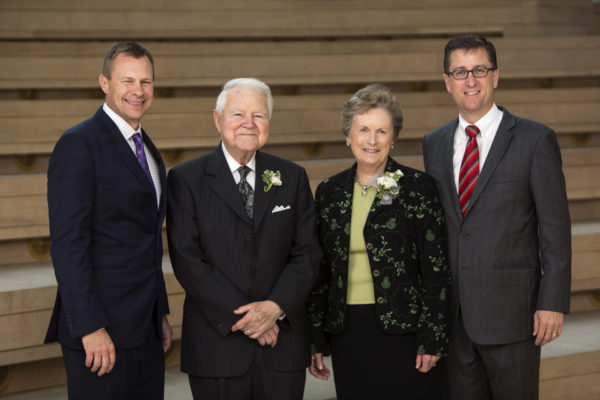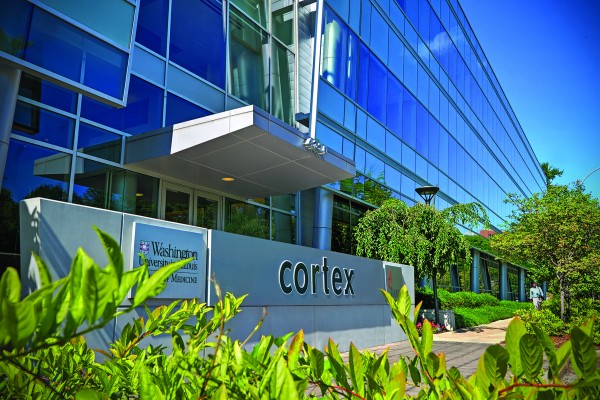Washington magazine recently spoke with George Bauer, BSIE ’53, MSIE ’59, a dedicated Washington University alumnus and chairman and CEO of GPB Group, Ltd., an investment banking firm he launched in 1987 after retiring from a 31-year career at IBM; and Robert O’Loughlin, chairman and chief executive officer of Lodging Hospitality Management. The conversation with the two long-time business partners and emeritus trustees of Washington University, centered on the recent revival of St. Louis Union Station, particularly their decision to purchase the property, their vision for its renewal, and how the stunning results are resonating with families from near and far.
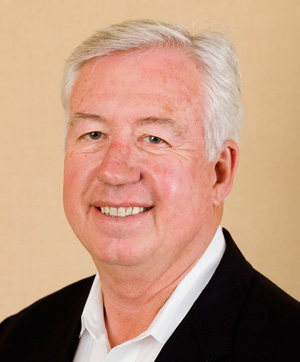
Q: How did it come to pass that the two of you would redevelop Union Station?
Robert O’Loughlin: George and I bought Union Station in 2012, because we both felt the iconic property was a real treasure. It has a great history; at the turn of the 20th century, it was the world’s largest train station — one that enabled St. Louis to host the 1904 World’s Fair and also the first modern Olympic Games on U.S. soil. And Francis Field and WashU became an integral part of that. There were many other firsts during the 1904 Olympics: first time they had the decathlon; first time they gave out a gold, silver and bronze medal; first time an African American was in the Olympics, and he won. The history of the station also shows that anytime someone wanted to go from the East Coast to the West Coast, generally they would have to go through Union Station. So, George and I were very excited about preserving this asset for the city of St. Louis, because it was imperiled and basically going out of business.
George Bauer: I’d like to add that when Bob and I walked into Union Station, especially the Grand Hall, and began to understand more of its background and just its massiveness and grandeur, I use the phrase, “It gave me goosebumps.” It’s something to behold, and to think that something like that would drop out of existence or not prosper was not OK with Bob and me. I would say that when we were talking to the bank and the receiver and realtor about purchasing the property, we didn’t know how it would shape up. We knew, however, that it had to be shaped up. It was then we began to ask ourselves: What does St. Louis really need?
Q: When you were considering redevelopment plans for Union Station, how did an aquarium get added to the mix?
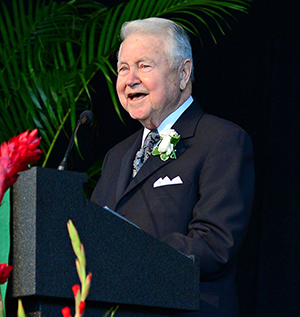
O’Loughlin: For the first couple of years, we concentrated on renovating all the guest rooms and also on adding meeting and exhibit space. It’s unique for hotels in the United States to have their own exhibit halls; usually convention centers host exhibits and hotels have ballrooms and meeting space. But since we had such a large amount of space, we converted the midway where people actually got on the train, into a large 50,000-square-foot exhibit hall. We had another 125,000 square feet left, formerly underutilized retail, so we started thinking about what would be good in that space. And it dawned on George and me that St. Louis is the largest city that doesn’t have an aquarium. It had been talked about over the years, and we felt, particularly after visiting many aquariums around the country, that an aquarium would fit in there very nicely. It was then we hired PGAV to design it.
Once we made that decision, we determined that a wheel would probably complement it. George and I flew over to Amsterdam and visited two companies there and then visited one in Wichita, Kansas. While visiting a wheel in Washington, D.C., we saw a carousel next to it, and then we decided to put in a carousel and a children’s play area next to the wheel. We actually got those elements completed faster than the aquarium and opened them along with two restaurants. Looking to create a complete family entertainment experience, we felt that an ice cream and candy shop would be good. Therefore, we took the old Hard Rock Café and turned it into a ’50s-, ’60s-style soda fountain, and it’s turned out to be a destination all its own. It’s extremely popular, as is the wheel, which gives the St. Louis skyline a different look. The wheel is also very attractive, especially at night when the more than 1,600 LED lights are on.
Bauer: We were interested in creating a family destination from the outset. And it’s kind of symbolic, picking up on a point Bob made, that we replaced the Hard Rock Café with the Soda Fountain.
Q: How did you go about choosing PGAV Destinations as your design firm for the aquarium?
Bauer: We visited a lot of aquariums, and we saw PGAV’s work in a lot of places. Mike Konzen’s company is one of the best in the world, and they’re local, so we chose them.
Q: What was the biggest challenge in creating the aquarium?
O’Loughlin: To build an aquarium inside the facility was probably the biggest challenge, which took a lot of work as far as design and execution. And, along with the challenge of obviously building all the facilities, we make our own saltwater for the marine side.
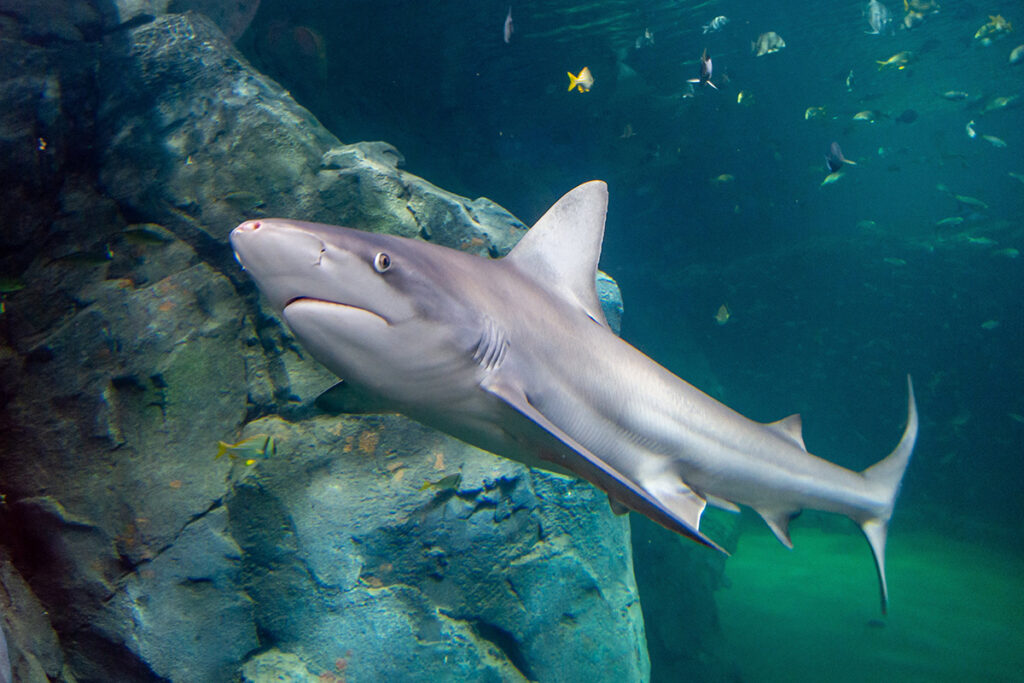
Q: What has been the biggest surprise since the opening of the aquarium?
O’Loughlin: The overwhelming publicity and press and excitement for the facility. I don’t think either one of us anticipated how much everybody was looking forward to the opening, and then when we opened it, we had over 100,000 people visit in the first two weeks. It’s far exceeded the number of people we thought would come and enjoy it. And I think part of that reason is that if you look back on the history of St. Louis, the Arch was built in the sixties, the City Museum, Magic House, Six Flags were completed 20, 30, 40+ years ago. St. Louis was really looking for a new major attraction, and we delivered it with a quality project. And people are thrilled.
I get stopped on the street every day. It speaks to the values of Midwestern people, just thanking us for doing something like this. George and I were doing it from a business venture. But it’s turned into probably much more knowing just how much it’s going to mean to families, not only that live in St. Louis but that visit the city in the future.
And I would add one other point: When Bob and I decided to put in the aquarium, it occurred to us that here St. Louis is located on the banks of one of the great rivers of the world and at the confluence of two of the great rivers of the world, just north of the city, and we know very little about the content of that water, other than it floods more than it should. And our major local universities don’t offer much in the way of aquatic sciences, so we decided to focus also on education and set up a foundation, which is a sister organization to the aquarium. Bob and I funded it with a $1 million contribution each, and we’re going to give a portion of our income to it.
One of its major missions is the conservation of water and seeing water as a resource that we really need to protect — as a subset of all the environmental work we need to do. Working with St. Louis city and county school systems, we have set a goal of having every youngster in the area gain an understanding of aquatic sciences. And it’s our hope to encourage youngsters to gain an interest in this body of water, that is right at their doorstep. To assure every student, independent of whether he or she is able to afford admission to the aquarium, gets a chance to come and experience the simulation of actually being underneath the Mississippi River. The foundation has also set up a separate area for students to learn facts about water and about water conservation. I think it has, as the phrase goes: “Great redeeming social value.”
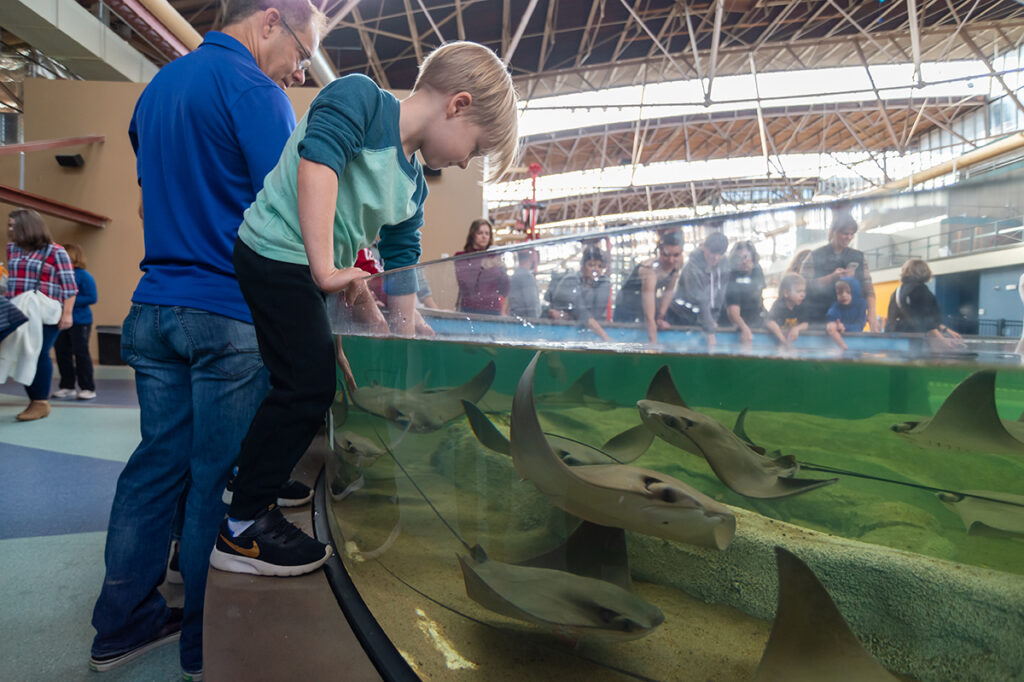
And we’re working with Jonathan Losos of WashU (the William H. Danforth Distinguished University Professor and director of the university’s Living Earth Collaborative, a center for the study of biodiversity in partnership with the Missouri Botanical Garden and the Saint Louis Zoo) on developing the educational portion.
Q: Are there any other unique features to your overall redevelopment?
O’Loughlin: All the major train companies had their offices in the facility’s tall clock tower. And there were 28 train companies, so we converted these offices into 28 guest rooms. We put the original name of each company on a frosted glass door with a transom and made it look historical, and they are now our most popular guest rooms.
And, of course, the Grand Hall, we completely renovated that space. And we wanted to do something special like at the Peabody, where ducks walk through the lobby and splash around every day at 5:30. So, we hired a young man’s company out of Orlando, and we created a 3D lightshow with music. The space formerly wasn’t a very active center, but now we do over 50 weddings a year and host many other social events. And in 2015, we won a Thea Award for Outstanding Achievement, which is equivalent to an Academy Award in the theatrical and entertainment business. George and I put on our tuxedoes and flew out to L.A., and we got the award along with Disney for “It’s a small world,” and Universal for Harry Potter.
Bauer: We were the low-budget entry, and we won!
Q: Have the results met or exceeded your expectations?
O’Loughlin: They’ve exceeded our expectations! For example, in late January, we hosted the NHL All-Star Game Fan-Fest at Union Station, and we had about 10,000 people a day for three days. People were thrilled with all the activities and everything we offer, including Jenna Fischer, who was on The Office for many years and who is from St. Louis. As a lot of people do, she wanted to bring her family down to Union Station, so we hosted her and husband, their two children, and her mom and dad, and they took a tour of the aquarium. We also showed them our ropes course and our mirror maze for children, and they ended up in the Soda Fountain enjoying milkshakes. Afterward, she went online, she has 2 million followers, and talked about how thrilled she was to come back to St. Louis and see the facility. And she and her parents wrote a nice note back stating that out of all of the places they’ve visited, they were just blown away with Union Station. So, we have another fan, as we do with Joe Buck. His family has been down three times. (And you can’t beat that kind of publicity.)
Bauer: And you can’t buy it either! Bob and I really have a great affection for St. Louis. Although I now live in Connecticut, I was born in St. Louis and then raised on a farm just south of there. And Bob used to live here in the East and now lives in St. Louis. It’s an undiscovered gem in our view. And we just felt that doing this project would enliven and enhance the downtown area and make it a lot more livable. And after Andy Taylor and his family have been awarded an MLS team and are now building a soccer stadium, which will be our next-door neighbor, that puts the icing on the cake. I just think Union Station and the soccer franchise and associated stadium are going to transform downtown St. Louis, which was what we were struggling with how to do back in 2014.
And just to cap it off: We thought Union Station and the aquarium would be good, but it’s turned out to be dynamite.
